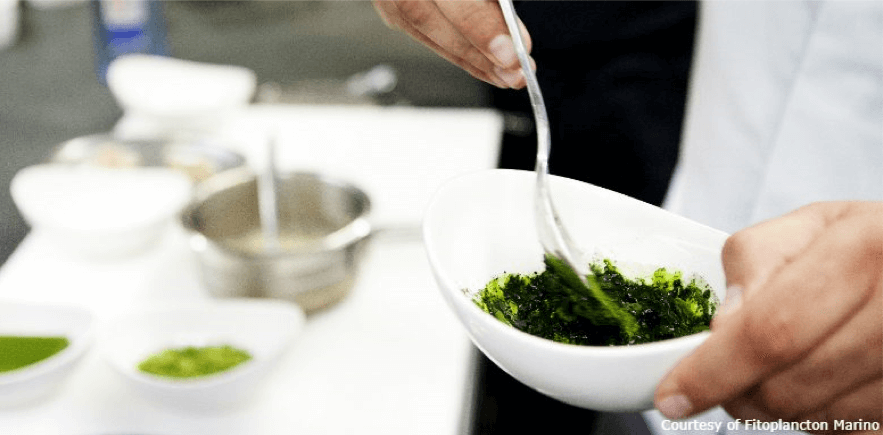Top trends straight from the world’s largest food science expo
By Rob Bianchin
From innovative fermented foods to algae and ancient grains, this year’s Institute of Food Technologists (IFT) Food Expo showcased the latest and greatest from around the globe. Here are the top emerging trends for the foodservice and restaurant industry:
Algae as a flavour enhancer
Different varieties of algae such as marine phytoplankton, spirulina and kelp were prominently showcased at IFT 2017 as flavour enhancers and alternative protein sources. Modern applications of algae provide an excellent opportunity to innovate and push the envelope in the culinary world.
Marine phytoplankton is one such algae that can be used as an ingredient to add an umami flavour to various food applications. The nutrient dense composition allows marine phytoplankton to replace saturated fats as well as allergens in many food concepts such as sauces and dressings. Marine phytoplankton can also be used to enhance protein and nutritional content in baked applications such as muffins and extruded cereals. Uma, an innovative restaurant and culinary destination in Barcelona, Spain, serves up creative algae dishes including carbonara of marine plankton, tuna and oyster. Closer to home, Fresh, a Toronto-based vegetarian restaurant chain, offers spirulina and blue algae extract as add on items to smoothies, juices and power shakes.
Ancient grains and seeds for modern menus
A 2015 study showed that within a 30 day period, 30 per cent of all American adults purchased ancient grains in restaurants or at food retailers. Judging from the new food items showcased at IFT 2017, the demand for ancient grains continues to grow steadily.
While highly coveted grains and seeds such as quinoa, chia seeds, flax seeds and hemp are still very prominent, food innovators are taking it to the next level by using ingredients like puffed amaranth, sorghum, millet, buckwheat and teff. For chefs, restaurateurs and foodservice, the uses for ancient grains are endless. Uncle Ben’s, for example, has a quinoa and ancient grains rice medley made specifically for foodservice. Ancient grain ingredients add texture, flavour and nutritional benefits like protein, fibre, iron, manganese, copper and zinc, to traditional dishes.
Growth of gluten-free baking and pasta-making flours
Gluten-free is nothing new, but what is new is the introduction of novel flours and flour blends that can be used to create tasty and nutrient rich bakery menu items and pastas. According to MenuTrinfo, restaurants that add gluten-free options experience an average eight per cent lift in sales. This may help explain why between 2009 and 2012, gluten-free mentions on restaurant menus increased by a whopping 275 per cent.
In addition to ancient grain flours such as sorghum, quinoa and amaranth, other next generation gluten-free flours include fava bean, lentil, coconut, and konjac. Konjac flour is relatively new to the mainstream, and it will be interesting to see how konjac is worked into restaurant fare. On the product side, NuPasta, a Canadian company, has created a gluten-free, vegan pasta from konjac that is high in fibre and low in calories. Konjac flour itself is often used as a substitute for cornstarch, and can be added to thicken gluten-free soups, sauces and gravies. On the baking side, konjac flour can be added to gluten-free flour blends to make fibre-rich cookies, muffins and breads.
Fermenting spice blends and condiments
As consumers’ palates become more adventurous, chefs across the globe are experimenting with fermented foods to bring new and unusual flavours to menus. Fermented foods continue to be one of the hottest restaurant menu trends and an effective way to spice up traditional items like burgers, salads, soups, appetizers, vegetable dishes and so much more.
Taking the process of fermentation a step further, a prominent theme at IFT 2017 was the emergence of unique spice blends. These blends allow food manufacturers, foodservice and chefs to create fermented foods and dishes by simply adding the blends to the desired foods during the fermentation process.
Another trending item from IFT 2017 was Gochujang, a Korean fermented condiment typically made with red chili powder, glutinous rice, fermented soybean powder, barley malt powder and salt. It has a savoury, sweet and salty flavour, and can be used in soups, stews, salads and meat marinades. No doubt that as Gochujang gains popularity, it will be creatively fused into all types of dishes and cuisines.
About the author:
Rob Bianchin is Vice President of Blendtek, a premier innovative food ingredients and solutions company that supplies cutting edge ingredients including alternative protein sources like marine phytoplankton, natural extracts and sweeteners, gluten free products, functional food systems, proprietary blends, and much more. For more information, visit Blendtek.com and follow on Twitter @Blendtek_Inc.
